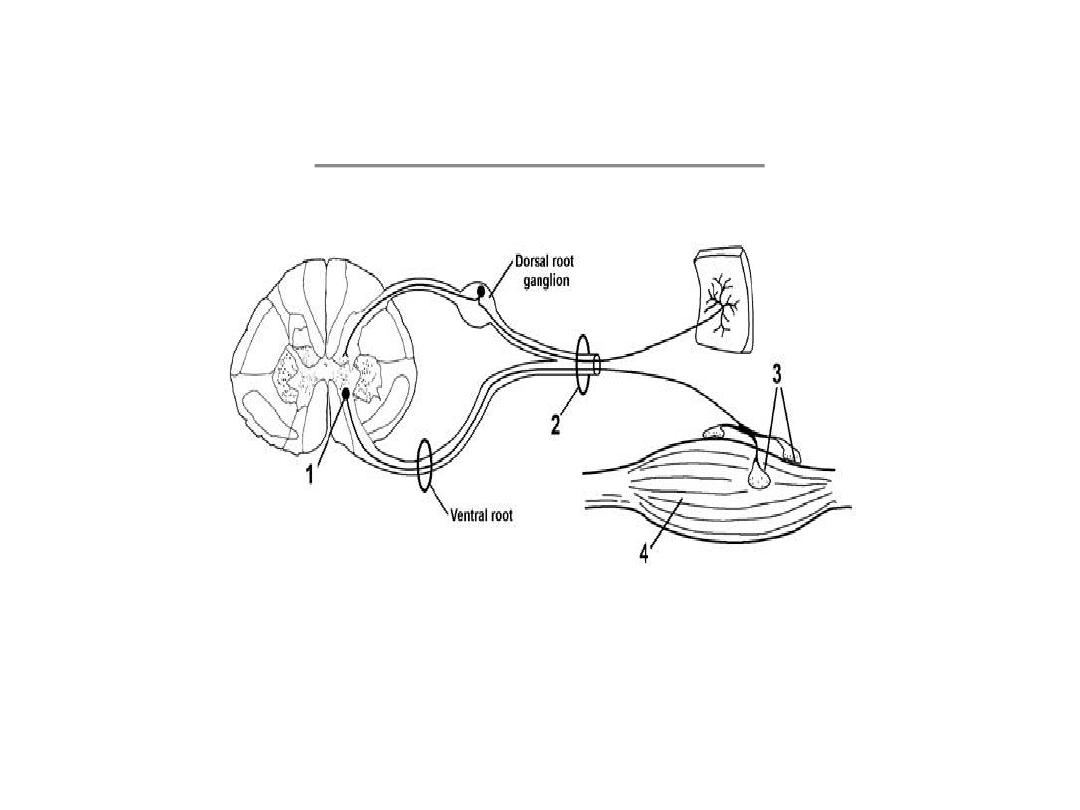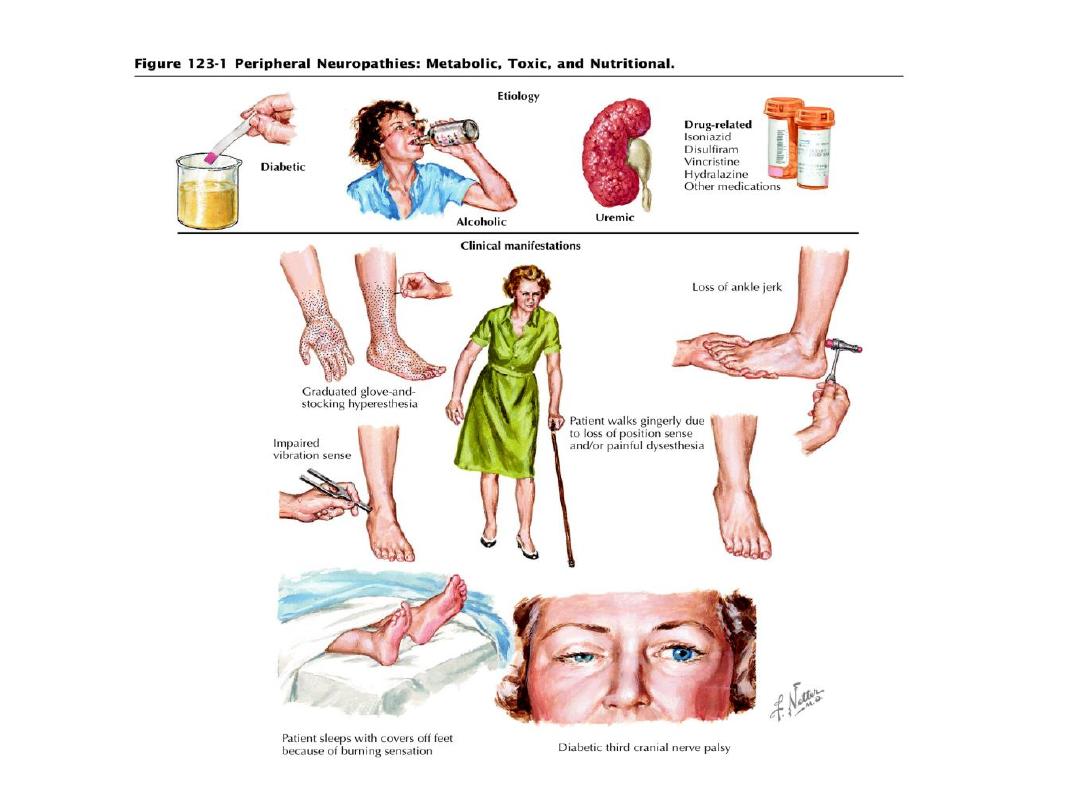
Peripheral neuropathy

Peripheral Neuropathy:
peripheral nerves are composed of sensory, motor, and
autonomic elements.
Diseases can affect the cell body of a neuron or its
peripheral processes, namely the axons or the encasing
myelin sheaths.
Most peripheral nerves are mixed and contain sensory
and motor as well as autonomic fibers. Thus, peripheral
neuropathies can impair sensory, motor, or autonomic
function, either singly or in combination.

• MONONEURITIS SIMPLEX
This term signifies involvement of a single
peripheral nerve.
• MONONEURITIS MULTIPLEX
Several individual nerves are affected, usually at
random and noncontiguous.
• POLYNEUROPATHY
The term “polyneuropathy” denotes a disorder in
which the function of numerous peripheral nerves is
affected at the same time. This leads to a
predominantly distal and symmetric deficit, with
loss of tendon reflexes except when small fibers are
selectively involved.

Approach to Neuropathic Disorders
▪ Is it Motor, sensory, autonomic, or combinations?
▪ Is it focal, symmetrical or asymmetrical?
▪ Is it Acute (days to 4 weeks), Subacute (4 to 8
weeks) or Chronic (>8 weeks)?
▪ Is there evidence for a hereditary neuropathy
(family history)
▪ Are there any associated medical conditions (DM,
cancer, autoimmune, connective tissue)?
▪ Drug history.


Causes of peripheral neuropathy
➢ Idiopathic inflammatory neuropathies
Acute idiopathic polyneuropathy (Guillain-Barré syndrome)
Chronic inflammatory demyelinating polyneuropathy.(CIDP)
➢ Metabolic and nutritional neuropathies
Diabetes
Hypothyroidism
Vitamin B
12
deficiency
➢ Infective and granulomatous neuropathies
AIDS, leprosy, diphtheria, sarcoidosis and sepsis.
➢ Vasculitis neuropathies
Polyarteritis nodosa
Rheumatoid arthritis
SLE
➢ Neoplastic and paraproteinemic neuropathies
Compression and infiltration by tumor
Paraneoplastic syndromes

➢ Drug ,alcohol and toxin induced neuropathies
Examples of drugs
• Pyridoxine
• Metronidazole
• Dapsone
• Isoniazid
Example of toxin:
• Organophosphates
➢ Heavy metal
• Lead, Thallium, arsenic
➢ Hereditary neuropathies
• Friedreich ataxia, CMT (Charcot-Marie-Tooth).
➢ compressive neuropathy:
• E.g.: carpel tunnel syndrome

• IDIOPATHIC INFLAMMATORY NEUROPATHIES
• Acute Idiopathic Polyneuropathy (Guillain-Barré
Syndrome)
▪ GBS is an acute or subacute polyneuropathy that can
follow minor infective illnesses, ,vaccination ,surgical
procedures, or may occur without obvious precipitants
▪ Clinical and epidemiologic evidence suggests an
association with preceding infection such as
Campylobacter jejuni, Cytomegalovirus , Mycoplasma
pneumonia, Epstein–Barr virus etc..
▪ Its precise cause is unclear, but it appears to have an
immunologic basis. Both demyelinating and axonal
forms have been recognized, with distinctive clinical
and electrophysiological features, The demyelinated
form is more common.

CLINICAL FEATURES
Diagnostic criteria for Guillain-Barré syndrome
Required for diagnosis
➢ Progressive weakness of more than one limb
➢ Distal areflexia with proximal areflexia or hyporeflexia
Supportive of diagnosis
➢ Progression for up to 4 weeks
➢ Recovery beginning within 4 weeks after progression stops
➢ Relatively symmetric deficits
➢ Mild sensory involvement
➢ Cranial nerve (especially VII) involvement
➢ Autonomic dysfunction
➢ No fever at onset
➢ Increased CSF protein after 1 weeks
➢ CSF white blood cell count ≤10/mL
➢ Nerve conduction study show slowing or block by several weeks

Against diagnosis
➢ Markedly asymmetric weakness
➢ Bowel or bladder dysfunction (at onset or persistent)
➢ CSF white blood cell count >50 .
➢ Well-demarcated sensory level.
Excluding diagnosis
➢ Isolated sensory involvement

Investigative studies.
• The cerebrospinal fluid (CSF) often shows a
characteristic abnormality, with increased
protein concentration but a normal cell count
(cytoalbumino dissociation); abnormalities
may not be found in the first week.
• Electrophysiological studies may reveal
marked slowing of motor and sensory
conduction velocity.

TREATMENT
• Plasmapheresis
appears to reduce the time required for
recovery and may decrease the likelihood of residual
neurologic deficits and need for ventilation a course of
plasmapheresis usually consists of 40–50 mL/kg
plasma exchange (PE) four to five times.
• It is best instituted early, and it is indicated especially
in patients with a severe or rapidly progressive deficit
or respiratory compromise.
• Intravenous immunoglobulin
(400 mg/kg/d for 5 days)
appears to be equally effective and should be used in
preference to plasmapheresis in adults with
cardiovascular instability and in children;
❑the two therapies are not additive.
❑no role for steroid.

In the worsening phase of GBS, most patients
require monitoring in a critical care setting, with
particular attention to
✓ Vital capacity
✓ Heart rhythm
✓ Blood pressure
✓ Deep vein thrombosis prophylaxis like heparin
and compressive stokes
✓ Cardiovascular status monitoring, and chest
physiotherapy.
As noted, 30% of patients with GBS require
ventilator assistance.

Prognosis and Recovery
Approximately 70-75% of patients recover
completely, 25% are left with mild neurologic
deficits, and 5% die from respiratory and
autonomic dysfunction.

Chronic Inflammatory Demyelinating
Polyneuropathy
CIDP is distinguished from GBS by its chronic course.
Onset is usually gradual over a few months or longer, but
in a few cases the initial attack is indistinguishable from
that of GBS.
An acute-onset form of CIDP should be considered when
GBS deteriorates >9 weeks after onset or relapses at least
three times.
Symptoms are both motor and sensory in most cases, in
other respects, this neuropathy shares many features with
the common demyelinating form of GBS.

Types of Diabetic Neuropathy
Peripheral Neuropathy.
Proximal Neuropathy(diabetic amyotrophy).
Autonomic Neuropathy.
Focal Neuropathy.



